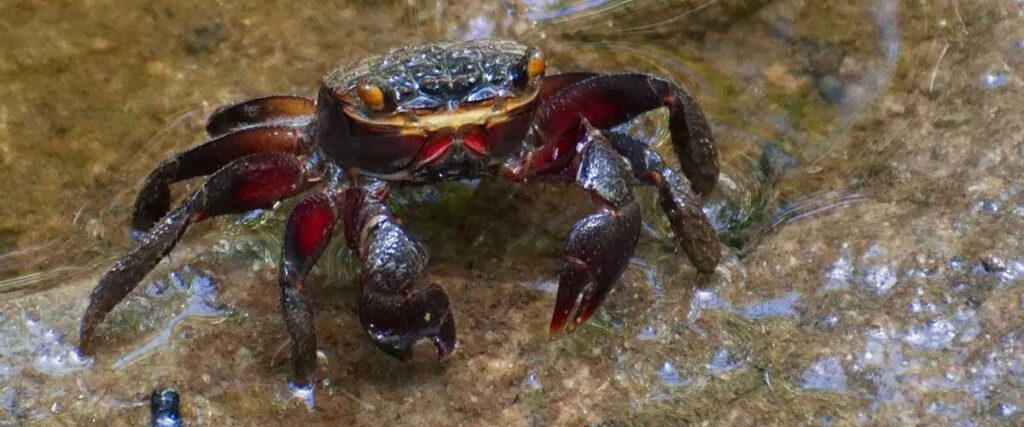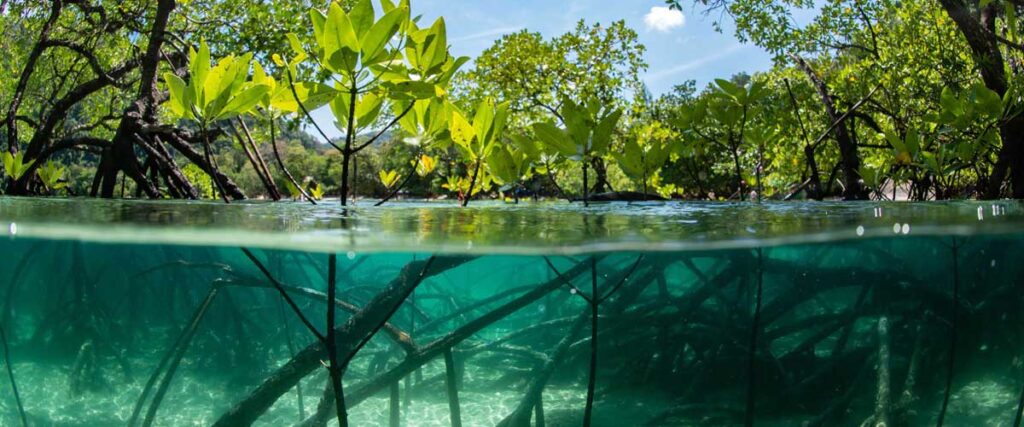
Protecting our planet from multiple threats – the forest defence with an otherworldly appearance.
With their unique ability to survive in the transition zone between land and sea, these salt-tolerant trees are among the most productive and biologically complex ecosystems on Earth. They battle climate change, shield coastlines from tempestuous seas, offer protection and shelter for countless marine species, and are vital for the survival of local communities. This is the global story of mangroves: their rise, fall, and resurrection.
To Protect and Serve
Mangrove forests, found at the edge of tropical and subtropical coastlines, are nutrient-rich breeding grounds for myriad species. Fish, birds, mammals and reptiles can all be found here – and the maze of twisted, stilted tree roots protects against predators, making them ideal nurseries. From Everglades National Park in Florida, which is home to threatened species of birds and amphibians, to the Australian mangroves where over 100 species of molluscs are found, to the Caribbean mangroves where rare green sea turtles dwell, these sea forests provide a critical habitat for many species.
The marine life – crustaceans, prawns, lobsters, crab and fish – that thrives in mangrove ecosystems supports local fisheries, providing food and revenue for coastal communities. The areas surrounding some of the forests are popular destinations for ecotourists, and revenue from activities such as birdwatching, kayaking and fishing can give an additional boost to local economies. But aside from providing a home for marine life and supporting people’s livelihoods, mangrove forests protect the structure of the coastline itself. The roots of the trees filter the water by trapping sediment, which slows coastal erosion, stabilises the shore, and stops sediment from damaging coral reefs and seagrass meadows.
Mangroves provide a formidable defence too against events such as storms and tsunamis. With the climate changing, severe weather events are becoming more frequent and sea levels are rising. Using mangroves as sea defences is five times more cost-effective than man-made alternatives. They are also vital in the battle against climate change itself. Mangrove ecosystems are powerful carbon sinks, sucking up carbon dioxide from the air to store in their roots and branches. Impressively, they can absorb up to four times more carbon than a rainforest the same size, and because they are submerged under tidal water when they die, the carbon is buried with them. But despite all the good that they do, mangrove forests are under threat from humans. Globally, 35% have been lost over the past 40 years and they are being razed faster than tropical rainforests.
Crime Fighters and Community Support
Believe it or not, resurrected mangrove forests have all-but ended criminal activity in parts of Kenya. By 2009, some areas had lost over 80% of their mangroves, causing a reduction in the fish stocks that villagers relied on for their livelihoods. Without fish, locals in places such as Gazi turned to logging as well as illegal poaching of elephant and rhino. Today, however, a programme of mangrove reforestation has created new and legal financial opportunities, resulting in criminal activity in the region dropping by 90% over a six-year period, according to the Kenya Wildlife Service.
In 2013, 117 hectares (289 acres) of mangrove forest around Gazi became a conservation area under the Mikoko Pamoja carbon offset project. In exchange for ensuring the health of the coastal mangroves, the project sells carbon credits, which can be bought in the form of an offset. As part of the project, casuarina trees were planted for as an alternative source of wood that could be sold for construction poles and firewood. Mangrove saplings were also planted as part of this community-led initiative. Involving the community in mangrove conservation from the outset is essential for any project to succeed. On the island of Madagascar, a scheme run by the conservation group Blue Ventures succeeded where others had failed by giving autonomy to the community to patrol the conservation zones themselves.
As an alternative to harvesting timber, sustainable incomes are managed, including sea cucumber and seaweed farming, and beekeeping. Now, deforestation is being reduced and even reversed – and, as is true of a lot of these schemes, women are being empowered.



Empowering Women
Over the past decade, some mangrove conservation schemes have offered new opportunities for women, including training and grants so they have the skills and backing to generate their own incomes. Women are also active members of the community beneficiary organisations (CBOs) – the groups set up to protect the mangroves – and take part in decision-making processes.
In Myanmar, 70% of the planters in one such project are women. They’re also trained in shellfish culture, while local girls and young women are awarded scholarships so they can attend school. In all, 4,600 people with low incomes benefit from an improved quality of life, getting their incomes from beekeeping, textiles and tailoring, as well as from crab and clam farming.
In eastern India, meanwhile, a female workforce is tasked with replanting mangroves, under a government employment scheme for rural households that”s credited with empowering women. The mangroves are now helping to protect fishing villages from storms and coastal erosion – and are also engaging in the battle against climate change by seizing carbon from the air. According to a study by researchers at the Bengaluru-based Indian Institute of Science, their mangrove scheme captured 102 million tonnes of carbon dioxide from 2017 to 2018.
Superpowers
Some of the largest nations on the planet are also capitalising on the benefits of mangroves to shore up coastline defences and increase biodiversity. Between the early 1950s and 2000, more than half of China’s mangroves were lost, but now, 75% of them are in protected areas, well above the global average of 42%. In Zhanjiang, in Guangdong province on the southern tip of the country, 400 hectares (990 acres) of new mangroves have been added to its 20,000 hectares (49,000 acres) of nature reserve. Countrywide, in the first two decades of the 21st century, there’s been a net increase of 5,000 hectares (12,000 acres) – a 23% jump.
In the United States, the natural sea defences offered by mangroves are being boosted along the Florida coastline – and there’s a real financial incentive to do so. According to one report, hurricanes, tropical storms, winds and flooding cause damage costing over $730bn (£550bn) globally every year– around $50bn (£38bn) of which is in the US alone. Restoring mangrove forests is a seen a way of getting those costs down – and protecting more than 15 million people worldwide.

Battling on
As the many powerful qualities of mangroves are slowly becoming better appreciated, more and more groups are working to halt the demise of these forests and even restore them to their former glory. Schemes range from small-scale replanting to replumbing the Everglades – all with an eye on the importance of sustainability. In some areas, mangroves had been lost to the financial security offered by agriculture and aquaculture. However, projects such as the one in Gazi, Kenya, prove that there is a profit to be made from conservation and restoration, not to mention protecting our green planet on a local and global scale. “Halting the loss of further mangrove habitat and restoration of lost habitat will not solve climate change alone,” says Jonathan Sanderman of the Woodwell Climate Research Center in the US.
“But for many nations, including most small island nations, mangrove protection and restoration represent one of the most viable climate mitigation options.”
This article was commissioned as part of ‘Our Green Planet’. This is a digital initiative, from BBC Earth in association with The Moondance Foundation, to raise awareness for the beauty and fragility of our planet’s green ecosystems.
Courtesy of: bbcearth.com



